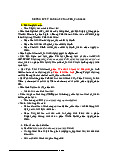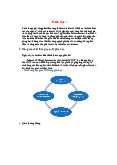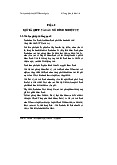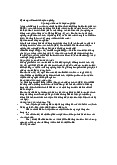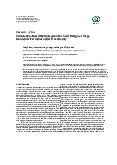














Preview text:
MẠNG MÁY TÍNH CƠ SỞ Week 9 : Question1:
Match each factor that influences the transmission of radio waves to its correct description.
OccurswhenRFwavesaresoakedupbywalls absorption
OccurswhenRFwavesstrikeanunevensurfaceandarereflectedinmanydirections scattering
OccurswhenRFwavesbounceoffmetalorglasssurfaces reflection Question2:
Match each of the following 802.11 topologies to its description.
Mobileclientsconnectdirectlywithoutanintermediateaccesspoint. Adhocmode
Thecommunicationdevicesuseasingleaccesspointforconnectivity BasicServiceSet(BSS)
toeachotherortowirednetworkresources.
Thewirelesstopologyistwoormoreservicesetsconnectedbya
ExtendedServicesSet(ESS)
distributionsystem(DS)or,morecommonly,awiredinfrastructure. Question3:
What is the most tangible benefit of wireless implementation? a.Betterproductivity b.Increasedmobility c.Improvedsecurity d. Cost reduction Question4:
What method does a WLAN use to control transmissions?
a.CSMA/CD(carriersensemultipleaccesscollisiondetect)
b.CSMA/CW(carriersensemultipleaccesswithcollisionweighting)
c.CSMA/CR(carriersensemultipleaccesswithcollisionrejection)
d. CSMA/CA (carrier sense multiple access with collision avoidance) Question5:
Which regulatory agency controls the 801.11 standard that governs WLANs? a.WISC b.EMA c.Wi-FiAlliance d. IEEE Question6:
Which organization offers certification for interoperability among vendors of 802.11 products? a.EMA b.IEEE c.WISC d. Wi-Fi Question7:
Which two are the unlicensed bands used by WLANs? a.900-MHzband b. 2.4-GHz band c.900-GHzband d.2.4-MHzband e. 5-GHz band Question8:
Which two of the 802.11 standards has the highest possible data rates? a.802.11 b. 802.11a c.802.11b d.802.11d e. 802.11g Question9:
Which 802.11 standard transmits using the 5-GHz band? a.802.11d b. 802.11a c.802.11 d.802.11b e.802.11g Question10:
Which is true about the Wi-Fi Alliance organization?
a.ItisaglobalstandardsorganizationthatcontrolsthecompatibilityofWi-Fiproducts.
b.ItoperatesonlyintheUnitedStatesandensuresthecompatibilityofWi-Fiproducts.
c.Itisaglobal,nonprofitindustrytradeassociationdevotedtopromotingtheinstallationofwireless
LANsinretaillocations.
d. It is a global, nonprofit industry trade association devoted to promoting the growth and
acceptance of wireless LANs. Question11:
What is a rogue access point?
a.AnaccesspointthatisbroadcastingitsSSID
b.AnaccesspointthathashadahardwarefailurethatcausesittoendlesslybroadcastitsSSID
c. An unsecured access point that has been placed on a WLAN
d.AnaccesspointthathasanopenWEPkey Question12:
Which three are the steps to secure a WLAN? (Choose three)
a. Encryption for providing privacy and confidentiality
b. Authentication to ensure that legitimate clients and users access the network via trusted access points
c.Controlstotransmitpowertolimittheaccesspointaccessrangetothepropertyboundariesofthe parentorganization
d. Protection from security risks and availability with intrusion detection and intrusion
protection systems for WLANs Question13:
Which standard provides the strongest level of WLAN security? a. 802.11i/WPA2 b.EAP c.WPA d.WEP Question14:
What factor determines which access point a client associates with?
a.TheaccesspointwiththehighestSSID
b.TheaccesspointwiththelowestSSID
c.TheaccesspointwhoseSSIDisreceivedfirst
d. The access point that is received with the strongest signal Question15:
When you are using 802.11x, how is the client authenticated?
a.Theaccesspointforwardsallnetworktraffictotheserverwhereitiseitherauthenticatedorblocked.
b.Theclientencapsulatesthe802.1xauthenticationtrafficbeforesendingittotheaccesspoint.This
causestheaccesspointtoforwardittotheserver.
c.Theclientisauthenticatedagainstalocaldatabasestoredontheaccesspoint.
d. The access point encapsulates any 802.1x traffic bound for the authentication server and sends it to the server. Question16:
Which is true when comparing WPA and WPA2?
a.WPAusespresharedkeyswhereasWPA2usesPSK.
b.WPAusesEAPauthenticationwhereasWPA2uses802.11x.
c.WPAusesaPersonalModewhereasWPA2usesanEnterpriseMode.
d. WPA uses TKIP/MIC encryption whereas WPA 2 uses AES-CCMP encryption. Question17:
What does the physical area of radio frequency coverage provided by an access point define?
a.Theadhocservicearea b.TheRFservicearea c. The basic service area
d.Theextendedservicesarea Question18:
When implementing Extended Service Areas, how much overlap is suggested?
a.25to30percent b.5to10percent c.15to20percent d. 10 to 15 percent Question19:
What strategy enables a client to communicate while moving?
a. The ability to shift data rates
b.Theabilitytomatchthetransmitleveltothereceivelevel
c.Theabilitytovarytransmitlevels
d.Theabilitytoperformerrorcorrectionasthesignallevelchanges Question20:
Which three are basic wireless access point parameters? a. SSID
b.Dataexchangerates
c.Transmitbandselection d. Authentication
e. RF channel with optional power Question21:
When implementing a WLAN, when should you use WEP?
a. Only if the hardware equipment does not support WPA
b.OnlyifanAAAserverisavailable
c.Whenyouareplanningtoenable802.11xauthentication
d.WhenyouneedtheincreasedsecurityofWEP Week 10 : Question1:
Which of the following contains routing information that helps a router in determining the routing path? (Choose three.) a. Routing protocol b. IP address c. Routing table d.MACaddress Question2:
Arrange the following steps of the routing process in the correct order.
Therouterreceivesapacketononeofitsinterfaces. Step1
Theoutgoinginterfaceprocessencapsulatesthepacketappropriatelytothemediaand Step5
sendsthepacketontothenetworksegment.
Ifthedestinationnetworkisonadirectlyattachednetwork,therouterwillusethe
ARPprocesstoobtaintheMACaddressofthehostandforwardittothenetwork
segment.Ifthenetworkisreachablethroughanotherrouter,therouterwillusethe Step4
MACaddressofthenext-hoprouterandforwardthepacketouttheinterface
indicatedintheroutingtable.
Therouterdeencapsulatestheframeandusestheprotocolinformationoftheframeto Step2
determinethatthenetworklayerpacketwillpasstotheIPprocess.
TherouterchecksthedestinationaddressintheIPheader.Eitherthepacketis
destinedfortherouteritselforitneedstobeforwarded.Ifthepacketneedstobe Step3
forwarded,theroutersearchesitsroutingtabletodeterminewheretosendthepacket. Question3:
Match each of the following method of populating a routing table to its definition.
Thisentrycomesfromhavinginterfacesattachedtonetworksegments.
Thisentryisobviouslythemostcertain;iftheinterfacefailsoris
Directlyconnectednetwork
administrativelyshutdown,theentryforthatnetworkwillberemoved fromtheroutingtable.
Theseroutesarelearnedbytherouter,andtheinformationisresponsive Dynamicrouting
tochangesinthenetworksothattherouterisconstantlybeingupdated.
Theseroutesareenteredmanuallybyasystemadministratordirectlyinto Staticrouting
theconfigurationofarouter.
Thisisanoptionalentrythatisusedwhennoexplicitpathtoa
destinationisfoundintheroutingtable.Thisentrycanbemanually Defaultroute
insertedorbepopulatedfromadynamicroutingprotocol. Question4:
Which of the following components are common to routers, switches, and computers (Choose three.) a. RAM b. CPU c. Motherboard d.Keyboard Question5:
Which of the following types of ports do routers have? (Choose two.) a. Console b.CD-ROM c.Printer d.USB e. Network Question6:
Which of the following statements best describe the functions of a router in a network? (Choose two.)
a.RoutersuseICMPtocommunicatenetworkinformationfromtheirownroutingtablewithother routers.
b.Routersstrengthenthesignaloverlargedistancesinanetwork.
c. Routers use the routing table to determine where to forward packets.
d.Routerscreatelargercollisiondomains.
e. Routers maintain their routing tables and ensure that other routers know of changes in the network. Question7:
Which of the following statements about the path determination process are accurate? (Choose three.)
a.Dynamicroutingoccurswhenthenetworkadministratorconfiguresinformationoneachrouter.
b.Adefaultrouteholdsanexplicitroutetoeverynetwork.
c. The routing process uses metrics and administrative distances when evaluating network paths.
d.Theroutingtableholdsmultipleentriespernetwork.
e. Routers evaluate the available paths to a destination.
f. Dynamic routing occurs when information is learned using routing information that is
obtained from routing protocols. Question8:
Which of the following statements describe the function of routing tables? (Choose three.)
a.RoutingtablesaremaintainedthroughthetransmissionofMACaddresses.
b.Althoughroutingprotocolsvary,routingmetricsdonot.
c. Routing table associations tell a router that a particular destination is either directly connected
to the router or that it can be reached through another router (the next-hop router) on the way to the final destination.
d.Whenarouterreceivesanincomingpacket,itusesthesourceaddressandsearchestheroutingtable
tofindthebestpathforthedatafromthatsource.
e. Routing tables provide an ordered list of known network addresses.
f. Routing tables contain metrics that are used to determine the desirability of the route. Question9:
Which of the following metrics are most commonly used by routing protocols to determine a network path? (Choose three.) a. Delay b. Hop count c.Distance d. Bandwidth e.Packetlength f.Quantity Week 11 : Question1:
Match each type of WAN device to its function. Othernetworking
WANsusethesetoprovideaccess. devices
TheyprovideinternetworkingandWANaccessinterfaceports. Routers
Inanaloglines,theyconvertthedigitalsignalofthesendingdeviceintoanalog
formatfortransmissionoverananaloglineandthenconvertthesignalbackto Modems
digitalformsothatthereceivingdevicecanreceiveandprocessthenetworksignal. Communication
Theyconcentratedial-inanddial-outusercommunications. servers Question2:
Match each type of connection on a router to its function.
provideatext-basedconnectionfortheconfigurationandtroubleshootingofthe Managementports router.
allowtheroutertoconnecttotheLANmediathroughEthernetorsomeother LANinterfaces
LANtechnologysuchasTokenRingorATM.
aremadethroughaWANinterfaceonaroutertoaserviceprovidertoadistant WANinterfaces
siteortotheInternet. Question3:
Match each type of communication link to its function in a WAN. Dedicated
Providesapre-establishedWANcommunicationspathfromthecustomer communicationlinks
premisesthroughtheprovidernetworktoaremotedestination Packet-switched
Transmitsdatainlabeledcells,frames,orpackets communicationlinks Circuit-switched
Dynamicallyestablishesadedicatedvirtualconnectionforvoiceordata communicationlinks
betweenasenderandareceiver Question4:
Which three statements accurately describe WANs?
a.ThecompaniesinwhichWANsareimplementedusuallyowntheWANs.
b. WANs use serial connections of various types to provide access to bandwidth.
c.WANsconnectdevicesthatareinasmallgeographicarea.
d. WANs connect devices that are separated by wide geographic areas.
e. WANs use the services of carriers such as telephone companies, cable companies, satellite
systems, and network providers.
f.WANsgenerallycarrylimitedtypesofdataathighspeeds. Question5:
Which three communications needs do WANs address?
a.Adepartmentneedstosharelargedatafilesquickly.
b.Administrativestaffwithinaschoolneedtosharescheduleinformationwiththeteachers.
c.Workersinasmallbusinessneedtobeabletocommunicateandsharedatawitheachother.
d. Organizations often want to share information with other organizations across large distances.
e. Workers within a branch of a large company need to share project data with each other.
f. Students need to do research for classes by accessing library indexes and publications located
in other parts of their country and in other parts of the world. Question6:
Which two statements accurately describe the difference between LANs and WANs?
a. Whereas a LAN connects computers, peripherals, and other devices in a single building or
other small geographic area, a WAN transmits data across broad geographic distances.
b.AWANtransmitsdatafasterthanaLAN.
c.AcompanyororganizationusuallyownsthehardwareandsoftwarerequiredforWANs.
d.LANsspanlargegeographicareasifaLANadministratorconfiguresthemcorrectly.
e. A LAN transmits data faster than a WAN. Question7:
At which OSI layer do WAN protocols describe how to provide electrical, mechanical, operational,
and functional connections to the services of a communications service provider? a.Layer3 b.Layer2 c. Layer 1 d.Layer4 Question8:
At which OSI layer do WAN protocols define encapsulation of data for transmission toward a remote
location and the mechanisms for transferring the resulting frames? a. Layer 2 b.Layer4 c.Layer3 d.Layer1 Question9:
Which two statements accurately describe data-link protocols in a WAN?
a. Many data link layer protocols use a framing mechanism similar to HDLC.
b. Data link layer protocols define how data is encapsulated for transmission to remote sites, and
also the mechanisms for transferring the resulting frames to establish the connection across the
communication line from the sending to the receiving device.
c.RIPisanexampleofadata-linkprotocol.
d.DatalinklayerprotocolsdeterminethecabletypetobeusedintheWAN.
e.ICMPisanexampleofadata-linkprotocol. Question10:
Which three statements accurately describe the functions of a packet-switching WAN communication link?
a. The cost of a packet-switched network to the customer is generally lower than with point-to- point leased lines.
b. The route that the packets take to reach the destination site varies.
c.ThePSTNusespacketswitching.
d. Packet-switched networks send data packets over different routes of a shared public network
owned by a carrier to reach the same destination.
e.Packetswitchingisacommunicationmethodinwhichusershaveadedicatedpathbetweensource anddestinationendpoints.
f.Inapacket-switchingnetwork,eachcustomerusesthefullbandwidthonitsvirtualcircuit. Question11:
Which command displays information about static route configuration on a Cisco router?
a.showrouteipstatic
b.showiproutestatic c.showrouteip d. show ip route Question12:
What does the command ip route 186.157.5.0 255.255.255.0 10.1.1.3 specify?
a. The router should use address 10.1.1.3 to get to devices on network 186.157.5.0.
b.Both186.157.5.0and10.1.1.3useamaskof255.255.255.0.
c.Youwanttheroutertotracearoutetonetwork186.157.5.0via10.1.1.3.
d.Theroutershouldusenetwork186.157.5.0togettoaddress10.1.1.3. Question13:
Which of the following protocols is an example of an exterior gateway protocol? a. BGP b.IGRP c.RIP d.EIGRP Question14:
In which situation is an administrative distance required?
a.Whendynamicroutingisenabled
b.Whenstaticroutesaredefined
c.Whenmultiplepathsareavailabletothesamedestinationandtheyarealllearnedviathesame routingprotocol
d. When the same route is learned via multiple routing protocols Question15:
When a router receives a packet with a destination address that is in an unknown subnetwork of a
directly attached network, what is the default behavior if the ip classless command is not enabled?
a.Forwardthepackettothedefaultroute b. Drop the packet
c.Forwardthepackettothenexthopforthedirectlyattachednetwork
d.Broadcastthepacketthroughallinterfacesexcepttheoneonwhichitwasreceived Question16:
How does a distance vector router learn about paths for networks that are not directly connected?
a. From neighboring routers
b.Fromthedestinationrouter
c.Fromthesourcerouter
d.Adistancevectorrouterlearnsonlyaboutdirectlyconnectednetworks Question17:
What does a distance vector router send to its neighboring routers as part of a periodic routing table update?
a.Informationaboutnewroutes
b.Informationaboutroutesthathavechanged
c.Informationaboutroutesthatnolongerexist
d. The entire routing table Question18:
What is the maximum allowable hop count for RIP? a. 15 b.6 c.30 d.60 Question19:
With RIP, load balancing is performed over multiple paths that have which characteristic? a.Equalweight b.Equalbandwidth c. Equal cost d.Equaldistance Question20:
Which command correctly specifies RIP as the routing protocol? a.Router(config)#rip
b.Router(config-router)#routerrip{ASno.}
c.Router(config-router)#rip{ASno.}
d. Router(config)#router rip Question21:
What is the default value of the RIP hold-down timer? a.30seconds
